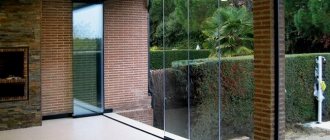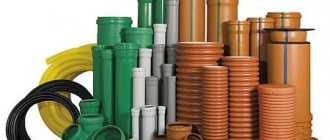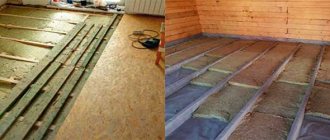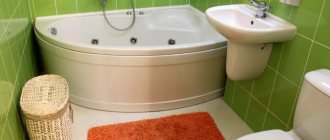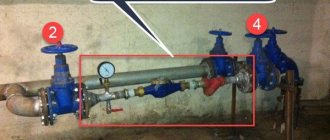Most residents of our vast Motherland, one way or another, face the problem of summer heat! Each of us understands that the best salvation from the heat in the apartment is a split system. The process of purchasing it is accompanied by two main questions: where to install the air conditioner in the apartment and which model to choose? Today I will tell you about the most successful options for the location of the air conditioner.
When we are just planning to purchase a “split”, many have no idea where in the apartment it should be located. For the first time, we think about where it is even possible to place the device so that it works correctly and efficiently. Many people have two versions in their heads:
- the first is the installation of one large air conditioner for the entire apartment (usually somewhere in the corridor);
- the second version is the installation of one or more split systems in certain rooms.
I stick to the second option, when the “split” is calculated for one room. And it’s even better when its power takes into account a small margin. Then the neighboring rooms can be partially cooled.
Factors influencing the choice of location
Each type of air conditioner has operating and installation features. The installation location largely depends on the type of device design. If this is a window model, then its location is obvious.
Window air conditioners are installed only on wooden frames.
This is not the best place to place the device. The big disadvantage of window air conditioners is the increased noise level during operation. You have to seriously think about the installation location when installing split systems. They consist of two blocks: external and internal.
The indoor unit must be located in the room so that the air flows it creates during operation do not reach people. They can cause various colds in him.
Furniture should not stand in the path of air flows. It reduces the efficiency of the split system. When installing air conditioners, factors such as the location of windows and doors in the room are also taken into account.
Expert opinion
Starostin Konstantin Adreevich
Air conditioner installation and maintenance specialist
If the device is installed in a room located on the sunny side, then the flow of cooled air should be directed perpendicular to the flow of heat entering the room through the windows.
It is better to place air conditioners on the opposite side of the door relative to the door. For the smooth operation of devices, it is important that they do not fall into draft areas. They can disable them. When installing air conditioners, you must follow the manufacturers' recommendations and a number of generally accepted rules and requirements.
Equipment for vacuuming and refueling
To work you need the following tools and devices:
- Vacuum station for air conditioners. Before charging the refrigerant, it connects to the circuit and drains it. The pressure gauges on the device show the vacuum level. In their work, craftsmen use two-stage models, which are economical in terms of energy consumption and easy to install. Heterion vacuum cleaners for air conditioners provide good cleaning, but they are rarely used because they are expensive.
- Gauge manifold.
- A set of screwdrivers and wrenches for working with fittings.
- Cylinder with freon for subsequent refilling.
The most important device is the pump, which will seal the pipeline. Ease of use is determined by the weight of the device - the lighter it is, the simpler it is. Models that have a rubber support to reduce vibration levels are more convenient to use.
During operation, the pump consumes oil, so indicating its level is a useful function for a person who constantly works with the device.
To remove vapors, a valve must be provided, as well as a set of fittings intended for the external unit, through which air is evacuated.
The market is dominated by equipment from German, American, and Swiss manufacturers of climate control equipment at various price levels. Some Chinese companies supply products that are not inferior in quality to their European counterparts, but are much cheaper.
Recommendations for installing air conditioners
Location recommendations
The devices are installed in apartments and houses to supply cooled or heated air. Approximately 80% of the efficiency of equipment depends on the correct choice of its location.
- It is recommended to hang the indoor unit of household air conditioners at a distance of at least 10 cm from the ceiling and 5 cm from the side wall . This will make cleaning the device easier and will not interfere with air intake. When hanging the split system closer than 10 cm to the ceiling, it will be impossible to remove the outer casing from it.
- The indoor unit must hang strictly horizontally . If the position of the device is skewed, the operation of its drainage system will be disrupted. Part of the condensate formed in it will not flow into the drain pan. This will lead to its stagnation. Mold will appear inside the appliance. An unpleasant odor will begin to spread throughout the living space. Do not hang the air conditioner further than 1.5 meters from the outer wall. If the distance is greater, it may be difficult to remove condensate through the drainage system to the outside. It will leak out into the room.
- There is no need to hang indoor units above tall cabinets . This will lead to the fact that the air conditioner automation will incorrectly determine the temperature of the entire room, and will perceive it only in a small installation area. The device will not be able to maintain the temperature set by a person in a living room. It is strictly forbidden to place air conditioners above heat sources. It will “drive them crazy.” They will work non-stop and will fail very quickly.
- The installation location of the devices should not be covered with curtains . There should be a free, unobstructed space in front of them. The distance to the nearest obstacle must be at least 3 m. Installation of the indoor unit in rooms with constantly operating devices with high-frequency electromagnetic oscillations can lead to damage to the indoor unit.
- The outdoor unit cannot be installed on closed balconies and loggias . This makes it very difficult to remove heat in the summer. When choosing a place to install it, you need to make sure that it is not exposed to direct sunlight. They can cause the equipment to overheat and shut down. The normal operation of the fan can be disrupted by gusts of wind. Therefore, the installation side of the outdoor unit should be as windless as possible.
- It is prohibited to install external units in places where explosive gases may leak, near treetops, or near the ground . It is better to fence external blocks installed on the first floors of buildings with bars. This will protect them from intentional damage by third parties. External units should not be mounted on fragile structures or near neighbors’ windows. The noise of a running air conditioner can cause interpersonal conflicts.
note
On the Internet you may come across conflicting advice from seemingly experienced professionals. For example, some masters, instead of vacuuming, use the so-called. purging the route with freon to displace most of the excess air from the system. This is an economical and fast method, but we strongly do not recommend using it.
Why? Firstly, this procedure is prohibited by most air conditioner manufacturers. Secondly, this method will not add many years of service to your air conditioner. If you ignore evacuating the system and instead use refrigerant purge, some air will still remain in the circuit. Over time, the insides of the device will become covered with a blue-black coating due to the oxidation process.
In a word, you should not save on such work. If you are unable to purchase a vacuum pump, rent one. Or entrust this work to a professional who has a full set of necessary tools, as well as invaluable experience.
Where is the best place to install air conditioning in an apartment?
The choice of equipment location depends on the layout of the apartment. In typical one-room apartments, the best option for installing air conditioners to create a comfortable microclimate is to install them in the room and in the kitchen. An alternative option for installing a split system is to place it above the doorway of the room or opposite it. With this arrangement of the device, the air flow will flow into the hallway and kitchen.
In multi-room apartments, adjacent rooms are equipped with one split system. It is located in the same way as in one-room apartments above the doorway connecting the rooms. In apartments with isolated rooms, one air conditioner can be located in the hallway. In multi-room apartments with complex polishing, multi-splits are usually installed.
Vacuum gauge readings
There are several possible options for the behavior of the vacuum gauge needle after the device is turned off:
- The readings indicate an increase in pressure, while the arrow again drops to the value of 1 atm, which was before the start of the evacuation process.
- The readings again indicate an increase in pressure, but the needle, falling, does not reach the 1 atm mark.
- The arrow does not change its position for more than fifteen minutes, showing the value “0”.
What could this mean? In the first option, when the arrow has reached a value of 1 atm at elevated pressure, you need to understand that there is most likely a leak in the system and it needs to be eliminated as quickly as possible. In the second option, where the arrow does not reach the value of 1 atm. at the same increased pressure means that it is necessary to continue the evacuation process, since there is still moisture in the system. The last option indicates a positive result of the operation, i.e. that the evacuation went well and moisture and air were completely removed from the system.
There are cases when the lack of tightness is detected much later, when operating pressure has already been created in the system. Therefore, after checking for vacuum, it is best to additionally test for tightness under pressure.
Features of installing air conditioners in the bedroom
The most common option for installing an air conditioner in the bedroom is side installation. It involves drilling holes for the external outlet on the side of the block.
The air conditioner is usually placed in the room on the walls:
- where is the TV installed?
- at the head of the bed.
The second option for installing equipment is considered safer. This is explained by the fact that the flows of cold air coming out of it are directed more directly than down. The likelihood of them getting into the sleeping area is minimal. When installing equipment, you must remember that the distance to the furniture from it should be at least 70 cm.
Materials for work
- a perforator for a hole in a main wall using a bunch of parts;
- drill with a collection of drills;
- special tubes along the length of the input with a small margin, insulating material for them;
- pipe cutter for cutting pipes and a file for removing burrs;
- four-wire electrical wire.
That's almost all you need to install an air conditioner yourself.
Try not to extend the line more than six meters, otherwise you will need a vacuum pump for freon. You can only find one from professionals. When connecting copper tubes, try to bend them carefully, otherwise the clearance will decrease. Have a meter of corrugated or PVC pipe to drain condensate from the outdoor unit.
DIY fan: how to make a homemade powerful fan. Basic parameters and properties of fans (130 photos)- Why do you need a security alarm, what functions does it perform?
How to choose winter workwear and not make a mistake - recommendations from the pros
Air conditioning of a private house
Features of location in a private house
To create a microclimate comfortable for living in a private home, ordinary household air conditioners and split systems are used.
There are mainly 2 air conditioning systems used:
- monoblock;
- window
The choice of location for air conditioners depends on the layout of the room.
TOP best models
There are many models of vacuum pumps on the market today. Devices such as Value VE115N, Value V-i220SV, Value VE-2100 are very popular among buyers in different price segments. They have collected many positive reviews and recommendations, which is a kind of guarantee of quality.
Best budget model
The Value VE115N pump is recognized as the leader in this category. This is a single-stage budget vacuum cleaner from a popular company with an extended service life. It provides high productivity - 51 l/min, has compact dimensions and weighs just under 7 kg. The power of the device is 185 W, the residual pressure in the system is 150 microns. The equipment has received greater accuracy in relation to previous models in the line. A wide inspection window is provided to check the oil level. The price of the device is within 5000 rubles.
The best model in the mid-price segment
In the category of semi-professional equipment in the mid-price segment, the Value V-i220SV model wins. The VI Series provides the deepest vacuum available from Value. This pump has a capacity of 51 l/min, a residual pressure of 1.6 Pa and a power of 250 W. It is equipped with its own vacuum gauge that helps monitor the residual pressure in the line. The design of the device includes an electromagnetic valve that automatically shuts off the input of the product after a power outage. Price – from 12900 rubles.
Best premium model
According to this criterion, many experts recognize the Value VE-2100 vacuum cleaner as the best. This is the most powerful 2-stage pump of this brand in the VE series. The vacuum depth is 2 Pa, productivity is 288 l/min, power is 750 W. The device operates from the network. Type – vane-rotor. The device is used for vacuuming climate control and refrigeration equipment. The price starts from 23,600 rubles.
Sources
- https://masterfibre03.ru/otoplenie-montazh/vakuumirovanie-sistemy-kondicionirovaniya.html
- https://MasterXoloda.ru/5/vakuumirovanie-i-proverka-kondicionera
- https://oventilyatsii.ru/vakuumirovanie-kondicionera-svoimi-rukami.html
- https://foundmaster.ru/climatic/chto-nuzhno-znat-o-vakuumirovanii-konditsionera.html
- https://vozduhstroy.ru/kondicionery/vakuumirovanie.html
- https://sovet-ingenera.com/vent/cond/vakuumirovanie-konditsionera.html
- https://delta-instrument.ru/montazh/vakuumirovanie-kondicionera.html
- https://venteler.ru/vakuumirovaniye-split-sistemy-poshagovaya-instruktsiya-po-primeneniyu/
- https://konder77.ru/articles/obsluzhivanie-konditsionerov/vakuumirovanie-konditsionera/
- https://odstroy.ru/vakuumirovanie-trassy-kondicionera-svoimi-rukami/
[collapse]
Questions and answers
Is it possible to install air conditioners next to gas equipment?
The distance between the air conditioner and gas equipment must be at least 40 cm.
What safety margin should brackets have for attaching external air conditioner units to building facades?
The brackets must have a 2-3 times safety margin.
Is it possible to mount an external air conditioner unit on decorative elements of buildings?
The rules for installing air conditioners on facades prohibit attaching them to decorative elements of facades.
Are there regulatory restrictions on the installation of external air conditioning units in multi-storey buildings?
To install an air conditioner on the facade of a multi-storey building, it is necessary to obtain consent from the residents of the building and the local government.
Where is the best place to place an air conditioner in a frame house?
The choice of installation location for an air conditioner in a frame house depends on its power. To eliminate unwanted vibration on the walls, the external unit is installed next to the house on the ground. The second option for air conditioning a house is to install 3 multi-splits on the foundation of the rear wall of the building.
Installation of air conditioners in residential premises must fit into the existing interior, ensure maximum efficiency of the equipment and be safe. Improper installation of devices can lead to their failure.
Crimping
After compressing the refrigerant in the compressor, and then in the pipeline section before the condenser, in the condenser itself and in the pipeline after the condenser (before the throttling valve), the refrigerant is under high pressure - 20-30, and sometimes 40 bar. All connections in the refrigeration circuit must be guaranteed to withstand this pressure. Therefore, after collecting the entire refrigeration circuit, the system is tested for leaks, i.e. pressure testing is performed. This occurs after complete installation of the refrigeration circuit of all indoor units, but before thermal insulation of the pipelines, before evacuation of the system. This is done in order to check the tightness of the refrigeration circuit and, if a leak is detected, quickly find it. To do this, the system is filled with nitrogen gas through the service connection.
Nitrogen is used at 99% purity to prevent various contaminants from entering the pipelines. Nitrogen is contained in cylinders at a pressure of about 155 bar or slightly more. Direct connection of the cylinder to the system is excluded. It is necessary to use a reducer, which allows you to reduce the pressure and fill with nitrogen at a lower pressure - 35-42 bar. The gearbox must be equipped with a safety valve with a response pressure of 70-75 bar. Refilling is always done through conventional hoses that are used for refrigerant charging.
After this, the drop in pressure is observed throughout the day. If the pressure drops, it means that there is a leak in the refrigeration circuit, which most often occurs in solder joints, in threaded connections. In such places it can be checked in several ways:
- by ear (possibly hissing);
- soaping (see the appearance of bubbles);
- using a leak detector.
Once a leak is detected, it is repaired and the pressure testing process is repeated. Pressure testing is repeated until the pressure in the circuit drops throughout the day.
In some cases, specialists do not use nitrogen for pressure testing, but immediately use a refrigerant. All refrigerants in the refrigeration circuit can be in a different state of aggregation, and when charged in gaseous form, entering, for example, a condenser, they can slowly condense, which entails a gradual drop in pressure in the system. This drop in pressure can be confused with a refrigerant leak from the system.
Another reason why you should not check the tightness with a refrigerant is its cost (it is much more expensive than nitrogen)
The process of rolling out pipes and laying them in a groove
Clear and competent actions will ensure not only a long life of the system, but will also make it possible not to redo such difficult work.
- 1. The preliminary stage consists of rolling out the pipes into a continuous line.
- 2. You cannot step on it - the material is very soft and can be damaged.
- 3. Be sure to put insulation on the pipeline.
- 4. When both blocks are connected, the cable must be hidden in a special corrugation.
- 5. The entire route is mounted in a prepared groove and secured with dowels and a product such as mounting tape.
From the side of the façade there should not be any visible elements protruding from the groove. This will lead to problems during plastering.

